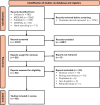Sedation for awake tracheal intubation: A systematic review and network meta-analysis
- PMID: 39468765
- PMCID: PMC11617133
- DOI: 10.1111/anae.16452
Sedation for awake tracheal intubation: A systematic review and network meta-analysis
Abstract
Background: Different sedation regimens have been used to facilitate awake tracheal intubation, but the evidence has not been synthesised robustly, particularly with respect to clinically important outcomes. We conducted a systematic review and network meta-analysis to determine the sedation techniques most likely to be associated with successful tracheal intubation, a shorter time to successful intubation and a lower risk of arterial oxygen desaturation.
Methods: We searched for randomised controlled trials of patients undergoing awake tracheal intubation for any indication and reporting: overall tracheal intubation success rate; tracheal intubation time; incidence of arterial oxygen desaturation; and other related outcomes. We performed a frequentist network meta-analysis for these outcomes if two or more sedation regimens were compared between included trials. We also performed a sensitivity analysis excluding trials with a high risk of bias.
Results: In total, 48 studies with 2837 patients comparing 33 different regimens were included. Comparing overall awake tracheal intubation success rates (38 studies, 2139 patients), there was no evidence suggesting that any individual sedation regimen was superior. Comparing times to successful tracheal intubation (1745 patients, 24 studies), any sedation strategy was superior to placebo. When we excluded trials with a high risk of bias, we found no evidence of a difference between any interventions for time to successful tracheal intubation. Thirty-one studies (1753 patients) suggested that dexmedetomidine and magnesium sulphate were associated with a reduced risk of arterial oxygen desaturation compared with other interventions, but excluding trials with a high risk of bias suggested no relevant differences between interventions. The quality of evidence for each of our outcomes was low.
Conclusions: To maximise effective and safe awake tracheal intubation, optimising oxygenation, topical airway anaesthesia and procedural performance may have more impact than any given sedation regimen.
Keywords: airway; awake intubation; drugs; network meta‐analysis; sedation.
© 2024 The Author(s). Anaesthesia published by John Wiley & Sons Ltd on behalf of Association of Anaesthetists.
Figures




References
Publication types
MeSH terms
Substances
LinkOut - more resources
Full Text Sources

